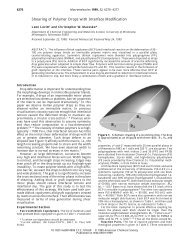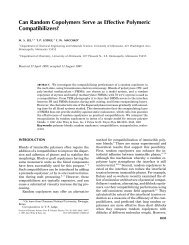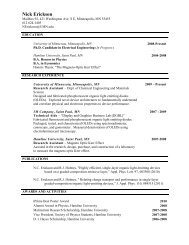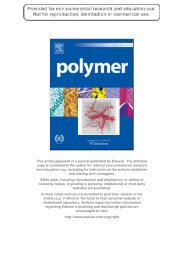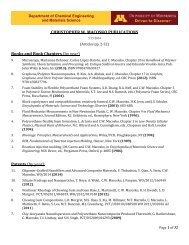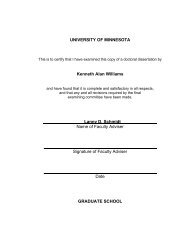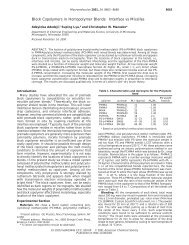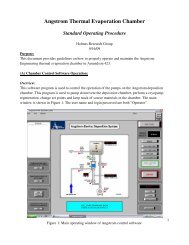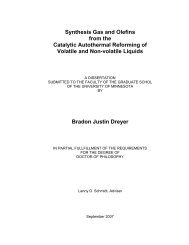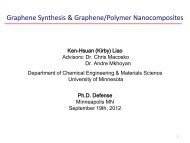Origins of concentric cylinders viscometry - CEMS Research Homes ...
Origins of concentric cylinders viscometry - CEMS Research Homes ...
Origins of concentric cylinders viscometry - CEMS Research Homes ...
Create successful ePaper yourself
Turn your PDF publications into a flip-book with our unique Google optimized e-Paper software.
<strong>Origins</strong> <strong>of</strong> <strong>concentric</strong> <strong>cylinders</strong> <strong>viscometry</strong>*<br />
Prasannarao Dontula, a) Christopher W. Macosko, b) and L. E. Scriven<br />
Department <strong>of</strong> Chemical Engineering and Materials Science,<br />
University <strong>of</strong> Minnesota, Minneapolis, Minnesota 55455<br />
(Received 7 March 2005; final revision received 27 April 2005�<br />
Synopsis<br />
The history <strong>of</strong> the <strong>concentric</strong> <strong>cylinders</strong> apparatus for measuring the shear viscosity <strong>of</strong> liquids, and<br />
its attribution to Maurice Couette, have been explored. Examination <strong>of</strong> the Nineteenth Century<br />
literature has revealed that the concept goes back to Stokes and later Margules, the design and<br />
execution <strong>of</strong> the apparatus, apparently independently, to Perry, Couette, Mallock, and Schwed<strong>of</strong>f.<br />
Mallock’s and Schwed<strong>of</strong>f’s measurements were the most accurate and were within 1% <strong>of</strong> the<br />
viscosities derived from Poiseuille’s measurements on the basis <strong>of</strong> no slip at the tube walls and<br />
cylinder surfaces. Measurement <strong>of</strong> fluid viscosity was closely linked to the adoption <strong>of</strong> the no-slip<br />
boundary condition at solid-fluid interfaces. © 2005 The Society <strong>of</strong> Rheology.<br />
�DOI: 10.1122/1.1940640�<br />
I. INTRODUCTION<br />
Concentric <strong>cylinders</strong> are widely employed to measure shear viscosities <strong>of</strong> “complex<br />
liquids,” i.e., liquids whose microstructures require more than microseconds, and typically<br />
milliseconds or longer, to equilibrate locally within a flow. Familiar examples are<br />
polymer solutions, certain surfactant solutions, concentrated suspensions <strong>of</strong> colloidal particles,<br />
and many composite colloidal and polymeric materials in chemical, food, and<br />
other technologies.<br />
Liquid contained in a narrow annulus between two coaxial <strong>cylinders</strong>, one or both <strong>of</strong><br />
which rotate, experiences a nearly uniform shear rate. In the simplest situation, one<br />
cylinder is stationary and the other is set in motion with either a constant velocity or<br />
constant torque. To arrive at the viscosity, the torque on the stationary element or the<br />
angular velocity <strong>of</strong> the moving element is measured. The ratio <strong>of</strong> the torque to the angular<br />
velocity is by a definition the shear viscosity <strong>of</strong> the liquid up to a constant.<br />
� =2�R 2 ��<br />
4��� �2<br />
R 2<br />
�2 o − �i��, �1�<br />
−1���<br />
where R is the radius <strong>of</strong> the inner cylinder, � is the ratio <strong>of</strong> the radius <strong>of</strong> the outer cylinder<br />
to that <strong>of</strong> the inner cylinder, �o and �i are, respectively, the angular velocities <strong>of</strong> the<br />
outer and inner <strong>cylinders</strong>, and � is the shear stress per unit length <strong>of</strong> the inner cylinder.<br />
*This paper is based on a portion <strong>of</strong> C. W. Macosko’s 2004 Bingham medal address, 15 February 2005,<br />
Lubbock, TX.<br />
a� Present address: General Electric, Global R&D, Bangalore, India.<br />
b� Author to whom correspondence should be addressed; electronic mail: macosko@umn.edu<br />
© 2005 by The Society <strong>of</strong> Rheology, Inc.<br />
J. Rheol. 49�4�, 807-818 July/August �2005� 0148-6055/2005/49�4�/807/12/$25.00<br />
807
808 DONTULA, MACOSKO, AND SCRIVEN<br />
Today, this flow is widely referred to as “Couette flow,” and the method “Couette<br />
rheometry,” after Maurice Marie Alfred Couette, who is regarded to have first constructed<br />
such an apparatus and made accurate measurements �Couette �1888, 1890��. Two authoritative<br />
reviews in the 1930s �Dryden et al. �1932�, Graetz and Stöckl �1931�� established<br />
beyond doubt that at least two other researchers independently designed and built similar<br />
devices at around the same time, if not earlier. However, neither <strong>of</strong> these reviews is<br />
complete. Nor is Donnelly’s �1991� recent account <strong>of</strong> the history <strong>of</strong> <strong>concentric</strong> cylinder<br />
flow. Here we recount and evaluate the Nineteenth Century work <strong>of</strong> Mallock, Schwed<strong>of</strong>f,<br />
and Perry, as well as <strong>of</strong> Couette, with the <strong>concentric</strong> cylinder apparatus.<br />
II. NO-SLIP BOUNDARY COUNDITION<br />
A little background is germane. The story <strong>of</strong> the determination <strong>of</strong> fluid viscosity is<br />
closely linked with the adoption <strong>of</strong> the no-slip boundary condition at a solid-liquid interface.<br />
Navier �1823�, in his celebrated memoir on the laws <strong>of</strong> fluid motion, introduced and<br />
explained two coefficients <strong>of</strong> the internal resistance to slipping, one within the liquid and<br />
the other between the solid and the liquid �Navier �1823�, p.416�. Moreover, he did not<br />
explicitly use the word “viscosity” to denote the first. He also derived an expression for<br />
the fluid velocity in a circular tube by assuming perfect slip at the wall. �The flow rate<br />
would then vary with the cube <strong>of</strong> the tube radius, which he did not specifically mention.�<br />
In 1839, Hagen reported experiments in which the liquid flow rate in circular tubes varied<br />
with slightly more than the fourth power <strong>of</strong> the tube radius �Hagen �1839��. Sutera and<br />
Skalak �1993� established that in the same year as Hagen, Poiseuille submitted his experimental<br />
measurements on tube flow <strong>of</strong> liquids to the French Academy. In those measurements<br />
he clearly demonstrated that at sufficiently low liquid velocities, the flow rate<br />
through circular tubes varies with the fourth power <strong>of</strong> the tube radius. His result contradicted<br />
theoretical treatments available in 1839, and it was probably the reason it was not<br />
accepted until he repeated the experiments with additional liquids in the presence <strong>of</strong> a<br />
designated committee! By 1847, his experiments and measurements <strong>of</strong> liquid viscosities<br />
were fully communicated �cf. Sutera and Skalak �1993�� and thereafter became the standards<br />
to match. However, Poiseuille did not himself calculate the absolute viscosity <strong>of</strong><br />
liquids, for that would have been tantamount to adopting the no-slip boundary condition<br />
at the tube wall.<br />
Stokes �1845� in his memoir was probably the first to argue that the liquid next to a<br />
solid wall is at rest. But he found that his formulas �which he does not report� did not<br />
agree with the experiments <strong>of</strong> Bossut and Dubuat from 70 years earlier �cf. Stokes<br />
�1845�, p.96�, which, it is today clear, fell in the turbulent regime <strong>of</strong> tube flow. However,<br />
two pages later he later mentions �cf. Stokes �1845�, p.98�:<br />
Dubuat found by experiment that when the mean velocity <strong>of</strong> water flowing through<br />
a pipe is less than one inch in a second, the water near the inner surface <strong>of</strong> the pipe<br />
is at rest. If these experiments may be trusted, the conditions to be satisfied in the<br />
case <strong>of</strong> small velocities are those which first occurred to me, and which are included<br />
in those just given by supposing �=�.<br />
Stokes’ � is now known as the slip coefficient �or its inverse�. He then derived an<br />
expression for the velocity pr<strong>of</strong>ile <strong>of</strong> flow in a tilted pipe <strong>of</strong> radius a �cf. Stokes �1845�,<br />
pg. 105�:
ORIGINS OF CONCENTRIC CYLINDERS VISCOMETRY<br />
g� sin �<br />
w =<br />
4� �a2 − r2� + U, �2�<br />
where U was the velocity close to the pipe surface. Unfortunately, Stokes was not aware<br />
<strong>of</strong> Poiseuille’s more accurate measurements, or the no-slip boundary condition would<br />
have been adopted earlier. Hence, he suggested that the flow between coaxial <strong>cylinders</strong> in<br />
relative angular motion with respect to each other be used to elucidate the “friction in<br />
liquids” and also the boundary condition at a solid wall �Stokes �1845�, p.104�. �Many<br />
years later, Margules apparently independently suggested using the same flow to measure<br />
the “coefficients <strong>of</strong> friction and gliding” in 1881 �Margules �1881���. One year later, in<br />
his 1846 report to the British Association, Stokes interpreted Coulomb’s oscillating-disk<br />
experiments as supporting his arguments for no slip at a solid wall, but he did not<br />
advocate this boundary condition unequivocally �Stokes �1846��. Five years later, Stokes<br />
�1851� verified the no-slip boundary condition at solid-fluid boundaries in his celebrated<br />
study on the motion <strong>of</strong> pendulums �Stokes �1851�, see pp. 14–5, 103�.<br />
It was not until the late 1850s and early 1860s that an exact expression <strong>of</strong> the liquid<br />
velocity and flowrate in laminar flow in a circular tube was published—independently by<br />
three researchers. Jacobson ��1860�, p.91� derived the formula, was probably the first to<br />
call it “Poiseuille’s law,” and verified it with an extensive set <strong>of</strong> his own experiments. He<br />
credited the derivation to Neumann. In March 1860, Hagenbach published the same result<br />
�Hagenbach �1860�, pp. 394–739�, and commented on Navier’s error in a footnote. In<br />
1863, Mathieu derived the same formula �Mathieu �1863��. Each <strong>of</strong> the earlier adopted no<br />
slip at the solid-liquid boundary. However, when in April 1860 Helmholtz published the<br />
formula for tube flow, he included a slip coefficient because he had compared his results<br />
with some inaccurate early experiments. This issue <strong>of</strong> slip appears not to have been<br />
resolved in that era, because even Lamb, in the first edition <strong>of</strong> his treatise Hydrodynamics<br />
in 1879 �Lamb �1879��, reproduced Helmholtz’s formula for tube flow, and mentioned<br />
that when slip at the walls was neglected, the resulting formula agreed with Poiseuille’s<br />
experimental results, in particular the fourth-power dependence <strong>of</strong> flow rate on tube<br />
diameter.<br />
It was in this context that Couette, Mallock, Schwed<strong>of</strong>f, and Perry published the<br />
results <strong>of</strong> their experiments with <strong>concentric</strong> cylinder devices in the next dozen years, and<br />
adopted the no-slip condition to extract the absolute viscosity. Interestingly, when Thorpe<br />
and Rodger delivered their famous Bakerian Lecture in 1894 on the relation between the<br />
chemical nature <strong>of</strong> liquids and their viscosities, they did not so much as mention the issue<br />
<strong>of</strong> slip or the <strong>concentric</strong> cylinder device �Thorpe and Rodger �1894��. And from his<br />
second edition �1895� onward, Lamb held it possible that there is no slip at solid boundaries<br />
“in all ordinary cases” �Lamb �1895�� He specifically cited not only Poiseuille’s<br />
results, but also Whetham’s �1890a, 1890b� conclusion from glass, silvered, and copper<br />
tubes slightly less than a millimeter in diameter “that no slip occurs, at any rate with<br />
solids that are wetted by the liquid.” Poiseuille’s tube diameters went down to 14 �m,<br />
and provided a much more severe test.�.<br />
Today no-slip is accepted as the wall boundary condition for the flow <strong>of</strong> all small<br />
molecule fluids that wet the boundaries. For example in a recent review <strong>of</strong> micr<strong>of</strong>luidic<br />
flows, �Stone et al. �2004�, p.388� conclude that “… the no-slip boundary condition<br />
remains an excellent approximation for flows at scales above tens <strong>of</strong> nanometers.” Measurements<br />
have been reported, however, <strong>of</strong> “apparent viscosities” <strong>of</strong> certain polymer<br />
solutions flowing through cylindrical pores in membranes, <strong>of</strong> four different diameters<br />
between 2.5 and 11 �m, lower than viscosities measured in larger tubes and gaps at very<br />
low rates <strong>of</strong> shear �Chauveteau �1982�, also cf. Aubert and Tirrell �1982��.<br />
809
810 DONTULA, MACOSKO, AND SCRIVEN<br />
FIG. 1. History <strong>of</strong> the <strong>concentric</strong> cylinder apparatus to measure fluid viscosity. Arrows connect those works<br />
cited by other authors. Perry, Couette, Mallock, and Schwed<strong>of</strong>f all built their first <strong>concentric</strong> cylinder device<br />
independent <strong>of</strong> each other. Perry built the first device; Couette and Mallock reported the first shear viscosity<br />
measurements; Schwed<strong>of</strong>f’s viscosity measurements were 0.2% lower than Poiseuille’s reported standards;<br />
Mallock was the first to build an apparatus in which either cylinder could be turned, and reported that the flow<br />
is unstable when the inner cylinder rotates �he was always above the critical Taylor number�.<br />
III. COUETTE’S CONTRIBUTION<br />
Couette �1890� studied both pressure gradient-driven flow in tubes and the rotational<br />
flow in an elaborate <strong>concentric</strong> cylinder apparatus. Piau et al.’s �1994� biography is the<br />
most complete account available <strong>of</strong> Couette’s personal life and scientific career. Couette’s<br />
theoretical correction for pressure loss at the tube entrance was more accurate than<br />
Hagenbach’s �1860� correction, from which it differed by a numerical multiplier �but<br />
Couette’s formula was identical to Neumann’s formula reported 30 years earlier by Jacobson,<br />
<strong>of</strong> which Couette was apparently unaware�. He also developed an experimental<br />
technique by which these corrections were totally eliminated. Couette’s <strong>concentric</strong> cylinder<br />
apparatus was inspired by Margules’ �1881� concept and Élie’s work with <strong>concentric</strong><br />
spheres �Élie �1882�� �see Fig. 1�. His measurements with the <strong>concentric</strong> cylinder<br />
device in which the inner cylinder was stationary were not accurate. His measured values<br />
<strong>of</strong> shear viscosity <strong>of</strong> water were higher than Poiseuille’s values by 15% �Couette �1890�,<br />
p. 460�. For instance, on page 460 <strong>of</strong> his 1890 publication he observed<br />
…Pour compléter la vérification, j’ai calculé le coefficient de frottement intérieur �<br />
de l’eau à 16,7°, en remplacant, dans la formule �13�, P/N<br />
par la valeur moyenne que nous venons de trouver. J’ai obtenu ainsi la valeur<br />
� = 0,01255<br />
au lieu que les expériences de Poiseuille, qui méritent toute confiance, donnent,<br />
pour la même température,
ORIGINS OF CONCENTRIC CYLINDERS VISCOMETRY<br />
� = 0,01096<br />
La valeur que j’ai trouvée est done trop forte d’environ 15 pour 100. Ce résultat me<br />
paraît dû aux imperfections de l’appareil, …<br />
He attributed the evident errors to the guard rings with which he tried to eliminate end<br />
effects �g and g� in Fig. 2�d��, and to the eccentricity <strong>of</strong> the <strong>cylinders</strong>. Eccentricity<br />
between coaxial <strong>cylinders</strong> does raise the measured torque �cf. Sommerfeld’s lubrication<br />
theory� and consequently the apparent viscosity, but in order to explain Couette’s discrepancies,<br />
the eccentricity in his apparatus would have to be in excess <strong>of</strong> 25% <strong>of</strong> the<br />
radial gap between the <strong>cylinders</strong>. Furthermore, Couette tabulated results <strong>of</strong> his experiments<br />
on water over 7 months, and his values were between 12.5% and 22.9% larger than<br />
Poiseuille’s values �Couette �1890�, p.461�. These errors were most likely due to his<br />
guard rings. Couette then calibrated his instrument with Poiseuille’s values <strong>of</strong> water<br />
viscosity, and thereupon estimated the viscosity <strong>of</strong> air. His estimate was 10% lower than<br />
James C. Maxwell’s and Oscar E. Meyer’s values, and 1% higher than O. Schumann’s<br />
values, all with the oscillating-disk method �Couette �1890� pp. 467–846�. Thus, his<br />
measurements <strong>of</strong> air viscosity with the <strong>concentric</strong> cylinder apparatus were not absolute as<br />
�Donnelly �1991�, p.37� claims.<br />
It is curious that Couette used the word “viscosity” sparingly; he preferred to use<br />
“coefficient <strong>of</strong> friction in liquids” �including in the title <strong>of</strong> his 1890 article�, even though<br />
across the English Channel the word viscosity had replaced “coefficient <strong>of</strong> friction” at<br />
least 25 years earlier �Kelvin �1865�, p.290�.<br />
IV. MALLOCK’S CONTRIBUTION<br />
Unremarked by Thorpe and Rodger �1894�, Mallock, working under the aegis <strong>of</strong><br />
Rayleigh, had independently constructed a <strong>concentric</strong> cylinder device <strong>of</strong> which the inner<br />
cylinder was stationary, measured the viscosity <strong>of</strong> water over a range <strong>of</strong> temperatures,<br />
and obtained results that were close to Poiseuille’s reported values �Mallock �1888�, p.<br />
131�. They were more accurate than Couette’s measurements, which were published the<br />
same year. In 1896, he recomputed the viscosities after G. G. Stokes pointed out that he<br />
had not used quite the right formula; his recomputed viscosities were “very close” to<br />
Poiseuille’s values. �We recomputed viscosities from Mallock’s �1888� data using the<br />
formula he gave �Mallock �1896�� and found them to be within 1% <strong>of</strong> viscosity values<br />
listed by Bingham �1922�, which in turn were 0.34% lower than those computed from<br />
Poiseuille’s measurements at 15 °C�. Towards the end <strong>of</strong> his paper, Mallock pointed out<br />
the significance <strong>of</strong> his own work<br />
The chief interest <strong>of</strong> these experiments, beyond that attaching to an independent<br />
determination <strong>of</strong> � by a new method, lies in the comparatively high velocities at<br />
which viscous forces remain the principal cause <strong>of</strong> resistance.<br />
He concluded his short paper with<br />
Many experiments were made on the viscosity <strong>of</strong> fluids other than water, but as I<br />
find that the results do not differ materially from those <strong>of</strong> Poiseuille it is unnecessary<br />
to give them here.<br />
Mallock’s arrangement to reduce end effects was ingenious and convenient, as much as<br />
Couette’s guard rings were elaborate. The bottom <strong>of</strong> the inner cylinder trapped an air<br />
bubble that separated the inner cylinder from the liquid beneath it �Fig. 2�c��. This design<br />
reduced the extra torque from the liquid sheared below the level <strong>of</strong> the inner cylinder.<br />
This design is now standard in the ARES rheometer �TA Instruments, New Castle, DE�<br />
and other commercial rheometers, though Mallock’s contribution has been forgotten and<br />
Mercier �1932� is generally credited with the invention �see Mooney and Ewart �1934��.<br />
811
812 DONTULA, MACOSKO, AND SCRIVEN<br />
FIG. 2. Concentric cylinder apparatus used to measure liquid viscosities and designed by �a� Perry �1883�, �b�<br />
Schwed<strong>of</strong>f �1889�, �c� Mallock �1888�, and �d� Couette �1890�.<br />
Mallock was a careful experimenter; the outer cylinder must have been transparent �he<br />
did not explain� because he observed and commented on a minute secondary flow set up<br />
between the stationary inner cylinder and the rotating outer cylinder by the bottom <strong>of</strong> the<br />
latter �Mallock �1888�, p.128�<br />
…It was found that at all these speeds the force tending to turn the inner cylinder
ORIGINS OF CONCENTRIC CYLINDERS VISCOMETRY<br />
B could be represented by the sum <strong>of</strong> two terms, one varying as the velocity and the<br />
other as the square <strong>of</strong> the velocity; the latter being small compared to the former,<br />
even at the highest speed.<br />
The cause <strong>of</strong> the square term seems to be that, owing to the action <strong>of</strong> the bottom <strong>of</strong><br />
the revolving cylinder, a circulation is set up in the fluid in the annulus, the flow<br />
being up the side <strong>of</strong> the revolving cylinder and down the side <strong>of</strong> the stationary one,<br />
the result being that the fluid having the velocity due to a position near the outer<br />
cylinder is by this circulation continuously carried near the inner one, thus making<br />
the variation in velocity in the neighborhood <strong>of</strong> the latter greater than it would<br />
otherwise be. As far as could be observed there was no trace <strong>of</strong> eddies with axes<br />
parallel to that <strong>of</strong> the two <strong>cylinders</strong>. The proportion between the two terms depends<br />
on the ratio between the length <strong>of</strong> the <strong>cylinders</strong>, and the breadth <strong>of</strong> the annulus, the<br />
square term become smaller and smaller compared to the other as the ratio increases.<br />
Pr<strong>of</strong>essor J. Thomson �Thomson �1876�, �1877�� has pointed out that a<br />
circulation having a very similar origin must take place in a stream when flowing<br />
round a bend.<br />
Rayleigh communicated this paper to the Royal Society. Mallock then built a new version<br />
<strong>of</strong> his apparatus and studied the stability <strong>of</strong> the flows with either the inner or the outer<br />
cylinder rotating and with a variety <strong>of</strong> end conditions; Kelvin communicated this paper to<br />
the Royal Society �Kelvin �1896��. Mallock’s results went largely unnoticed by those<br />
researching viscosity measurements, at least up to the time <strong>of</strong> Taylor’s �1923� landmark<br />
experiments and theoretical analysis. Even Leroux �1925�, who measured water viscosity<br />
with a greatly improved version <strong>of</strong> Couette’s device, made no mention <strong>of</strong> Mallock’s<br />
work. Hatschek �1913�, who measured the viscosity <strong>of</strong> suspensions, was among those<br />
who earlier had overlooked Mallock.<br />
V. SCHWEDOFF’S CONTRIBUTION<br />
In 1889, Schwed<strong>of</strong>f reported measurements <strong>of</strong> the elastic shear modulus <strong>of</strong> gelatin by<br />
tracing the liquid relaxation after an imposed deformation with a <strong>concentric</strong> cylinder<br />
apparatus �Schwed<strong>of</strong>f �1889��. In 1890, he reported the viscosity <strong>of</strong> water, castor oil,<br />
glycerin and a gelatin solution with a <strong>concentric</strong> cylinder device whose outer cylinder<br />
was made <strong>of</strong> glass �Fig. 2�b�� �Schwed<strong>of</strong>f �1890��. By that time he was aware <strong>of</strong> Couette’s<br />
work �cf. Piau et al. �1994��, and so he made clear that he had designed and built<br />
his apparatus independently �Schwed<strong>of</strong>f �1890�, p.38�<br />
…Je me suis arrêté à la méthode des deux cylindres concentriques, dont l’intervalle<br />
est rempli du liquide à étudier. Proposée d’abord par M. Margules pour l’étude de<br />
la viscosité des liquides, cette méthode avait éprové depuis des perfectionnements<br />
essentiels entre les mains de M. Couette �1888�, qui eut l’heureuse idée d’introduire<br />
dans son appareil duex cylindres de garde, pour simplifier la théorie de<br />
l’expérience. Par hasard, cette méthode se rapproche beaucoup de celle que j’avais<br />
adoptée pour mes recherches sur la rigidité des liquides, sans avoir pourtant connaissance<br />
des essais de M. Couette dans cette direction. Seulement, au lieu des<br />
cylindres de garde, je me suis servi du procédé d’elimination du fond que j’ai décrit<br />
dans la premiére Partie de ces recherches. �Schwed<strong>of</strong>fs emphasis�<br />
Schwed<strong>of</strong>f accounted for the extra torque from the liquid below the inner cylinder and<br />
subtracted it; this is the “process <strong>of</strong> bottom elimination” he refers to in the earlier passage.<br />
His measurement <strong>of</strong> water viscosity was 0.2% lower than Poiseuille’s value<br />
�Schwed<strong>of</strong>f �1890�, p.44�, more accurate than either Mallock’s or Couette’s measurements<br />
with the <strong>concentric</strong> cylinder apparatus. In the same work, he determined that the<br />
813
814 DONTULA, MACOSKO, AND SCRIVEN<br />
viscosity <strong>of</strong> a gelatin solution depended on shear rate. Schwed<strong>of</strong>f cited neither Mallock’s<br />
nor Perry’s work. Neither Graetz and Stöckl �1931� nor Donnelly �1991� cite Schwed<strong>of</strong>f’s<br />
work, but �Coleman et al. �1966� pp. 88–89� cite both his works, and also comment that<br />
Schwed<strong>of</strong>f’s measurements on the gelatin solution were probably the first report <strong>of</strong> a<br />
shear-thinning liquid viscosity in the steady flow between two coaxial <strong>cylinders</strong> free from<br />
“turbulence” or secondary flow.<br />
VI. PERRY’S CONTRIBUTION<br />
Perry’s contribution to the development <strong>of</strong> the <strong>concentric</strong> cylinder apparatus is the<br />
least known. Perhaps that is because he was a teacher �<strong>of</strong> engineering� first, and only<br />
secondarily a researcher. Once a student <strong>of</strong> James Thomson and an Honorary Assistant <strong>of</strong><br />
Kelvin at Glasgow, he later taught engineering at the Imperial College <strong>of</strong> Engineering in<br />
Japan �1875–1878�, at the City and Guilds <strong>of</strong> London Technical College in Finsbury<br />
�1882–1896�, and at the Royal College <strong>of</strong> Science in Kensington �1896–1913� before<br />
retiring �cf. J. C. Poggendorff Biographisch-literarisches Handworterbuch der exacten<br />
Wissenschaften 3–4, and obituary notice in 1926 in Proc. Roy. Soc. London A 111, i–ii�.<br />
His campaign to improve engineering education methods, and his efforts to bridge the<br />
gap between mathematicians and engineers were famous �cf. his obituary notice�. Perry<br />
also contributed prolifically to the scientific literature while he was teaching �an examination<br />
<strong>of</strong> the Catalogue <strong>of</strong> Scientific Papers compiled by the Royal Society reveals 105<br />
papers coauthored by Perry between 1875 and 1900�. Perry’s book Practical Mechanics,<br />
“an attempt to put before non-mathematical readers a method <strong>of</strong> studying mechanics”<br />
�Perry’s emphasis�, contains a drawing <strong>of</strong> a <strong>concentric</strong> cylinder apparatus similar to the<br />
“double-cup,” a current method to measure the viscosity <strong>of</strong> low viscosity liquids �Macosko<br />
�1994��. He also described the method he used to measure liquid viscosities �Perry<br />
�1883�, Sec. 242, pp. 248–249, also see Fig. 2�a��<br />
…Fig. 143 shows a hollow cylindric body, F, supported so that it cannot move<br />
sidewise, and yet so that its only resistance to turning is due to the twist it would<br />
give the the suspension wire, A. CC is water or another liquid filling the annular<br />
space between the cylindric surfaces DD and EE, and wetting both sides <strong>of</strong> F.<br />
When the vessel DD EE is rotated, the water moving past the surfaces <strong>of</strong> F tend to<br />
make F turn around, and this frictional torque is resisted by the twist which is given<br />
to the wire. The amount <strong>of</strong> twist in the wire gives us, then, a measurement <strong>of</strong> the<br />
viscosity <strong>of</strong> liquids, and investigations may be made under very different conditions.…<br />
He published his work on “liquid friction” in 1893. He began it by stating<br />
A piece <strong>of</strong> apparatus such as is used in this investigation was designed and partly<br />
constructed in Japan in 1876; it is described in my book on Practical Mechanics<br />
�1883�. The specimen actually used by us was constructed at the Finsbury Technical<br />
College in 1882, and occasionally used since that time, but no complete sets <strong>of</strong><br />
observations were attempted till October 1891.<br />
Perry was also concerned about the extra torque from the liquid sheared below the inner<br />
cylinder, i.e., end effects �Perry �1893�, p.442�, and his double gap design reduced it.<br />
Perry also claimed to have measured viscosities <strong>of</strong> several liquids, but reported only the<br />
abrupt fall in viscosity <strong>of</strong> sperm oil above 40 °C. His paper �one <strong>of</strong> the reviewers <strong>of</strong><br />
which was Reynolds� contained no references to Mallock, Couette, or Schwed<strong>of</strong>f.<br />
Perry’s work went unnoticed until Drew �1901�, working in Pr<strong>of</strong>essor Michelson’s<br />
laboratory at the University <strong>of</strong> Chicago, cited his work when he reported measurements<br />
on viscosity <strong>of</strong> water. Interestingly, Drew did not cite Couette or Mallock or Schwed<strong>of</strong>f.
ORIGINS OF CONCENTRIC CYLINDERS VISCOMETRY<br />
The <strong>concentric</strong> cylinder apparatus he used, he explained, was designed and built by his<br />
predecessor Johonnott, under the direction <strong>of</strong> Pr<strong>of</strong>essor Michelson. Subsequently Gurney,<br />
supervised by Pr<strong>of</strong>essor Michelson and Pr<strong>of</strong>essor Millikan, reported further work on<br />
water and cited Couette, but not Mallock, Schwed<strong>of</strong>f, or Perry �Gurney �1908��.<br />
VII. CONCLUSIONS<br />
The question <strong>of</strong> whether a fluid slips at a solid wall, and the determination <strong>of</strong> fluid<br />
viscosity are inseparable. The first issue was slip. Stokes’ illuminating research on viscous<br />
drag on spheres and slender <strong>cylinders</strong> �Stokes �1851�� was <strong>of</strong>fset by Piotrowski’s<br />
�and Girard’s� data, which Whetham �1890a, 1890b� finally showed were erroneous, and<br />
Helmholtz’s analysis <strong>of</strong> them in terms <strong>of</strong> slip �Helmholtz �1860��. Poiseuille’s data �1846�<br />
and Jacobson’s �or Neumann’s� analysis <strong>of</strong> them �1860� might otherwise have settled the<br />
issue; they did establish what became a primary technique for measuring fluid viscosity.<br />
Even as Lamb �1879� prolonged the ambiguity about slip by giving credence to the<br />
Helmholtz–Piotrowski paper, the experimenters who were developing viscosity measurement<br />
all adopted the no-slip hypothesis, as had Maxwell as early as 1866. And Maxwell<br />
�1866�, though fully aware <strong>of</strong> Helmholtz and Piotrowski, on the basis <strong>of</strong> his own and<br />
other experiments, stated<br />
I have no doubt that.… there is no slipping..…<br />
The leading alternative technique to Poiseuille’s flow emerged in the <strong>concentric</strong> cylinder<br />
apparatus frequently called the “Couette rheometer” after Maurice Couette, who is widely<br />
credited with devising the method and making the first accurate measurements. Dryden et<br />
al. �1932�, Graetz and Stöckl �1931�, and Donnelly �1991� all show that at least two<br />
others developed the same apparatus independently. But none <strong>of</strong> these reviews tell the<br />
whole story. Here we have re-examined the origins <strong>of</strong> <strong>concentric</strong> cylinder rheometry and<br />
its attribution to Couette.<br />
Stokes and later, Margules �1881�, separately proposed that the “coefficients <strong>of</strong> friction<br />
and gliding” �both seemed unaware that the no-slip boundary condition at the solidliquid<br />
interface had been conclusively established by Poiseuille’s experiments with tube<br />
flow� could be measured with a <strong>concentric</strong> cylinder apparatus. Margules solved for the<br />
flow allowing for some slip. Perry built the first <strong>concentric</strong> cylinder device to measure<br />
liquid viscosity in 1882, but he did not publish measurements until 1893. �Élie built a<br />
<strong>concentric</strong> sphere device in 1882 that was inconsequential except for catching Couette’s<br />
notice.� Couette’s measurements <strong>of</strong> water viscosity �1888, 1890� were between 10% and<br />
23% higher than Poiseuille’s reported values. His measurements <strong>of</strong> air viscosity were not<br />
absolute because he calibrated his apparatus with Poiseuille’s measurements on water.<br />
Mallock’s �1888� measurements <strong>of</strong> water viscosity were more accurate and within 1% <strong>of</strong><br />
those derived from Poiseuille’s measurements. The next year, �1889�, Schwed<strong>of</strong>f reported<br />
measurements <strong>of</strong> the elastic modulus <strong>of</strong> a gelatin solution with <strong>concentric</strong> <strong>cylinders</strong> <strong>of</strong> his<br />
own design. In 1890, he noted that his device was similar to Couette’s, and reported the<br />
viscosity <strong>of</strong> water measured with his apparatus that was only 0.2% lower than Poiseuille’s<br />
values. He also reported the first instance <strong>of</strong> a shear rate-dependent viscosity with measurements<br />
on a gelatin solution, foreshadowing widespread applications <strong>of</strong> Couette�–<br />
Mallock–Schwed<strong>of</strong>f–Perry� rheometers to rheological characterization <strong>of</strong> non-Newtonian<br />
liquids as surveyed by Coleman et al. �1966�, �Piau et al. �1994��. A little later Mallock<br />
�1896�, working under the eyes <strong>of</strong> Lord Rayleigh and his friend Lord Kelvin, built the<br />
first apparatus with which the inner cylinder could be rotated and found, inter alia, that<br />
the flow between <strong>concentric</strong> <strong>cylinders</strong> is unstable when the inner cylinder rotates. The<br />
815
816 DONTULA, MACOSKO, AND SCRIVEN<br />
ensuing history <strong>of</strong> flow stability, from Taylor �1923� onward, is summarized by Donnelly<br />
�1991�.<br />
It is interesting to note that the original <strong>concentric</strong> cylinder designers used four different<br />
approaches to eliminate end effects �see Dontula �1999� for further discussion�.<br />
Three <strong>of</strong> these are still the methods used today; only Couette’s guard rings did not<br />
survive. The falling weights which drove rotation in the first designs soon gave way to<br />
electric motors. Sensing <strong>of</strong> torque by mirrors reflecting onto meter sticks was replaced by<br />
capacitors but the torsion springs <strong>of</strong> the original designs remained for over 80 years. Only<br />
since the 1970s have springs been replaced by strain gauges and then rebalance transducers<br />
and constant torque drag cup motors �Macosko �1994��.<br />
ACKNOWLEDGMENTS<br />
The authors are indebted to E. G. Arlinghaus for her translations <strong>of</strong> the passages in<br />
French and to Dr. I. Iliopoulos for his help in translating the works in German. This<br />
research was supported by the members <strong>of</strong> IPRIME, the Industrial Partnership for <strong>Research</strong><br />
in Interfacial and Materials Engineering at the University <strong>of</strong> Minnesota.<br />
References<br />
Aubert, J. H., and M. Tirrell, “Effective viscosity <strong>of</strong> dilute polymer solutions near confining boundaries,” J.<br />
Chem. Phys. 77, 553–561 �1982�.<br />
Bingham, E. C., Fluidity and Plasticity �McGraw-Hill, New York, 1922�.<br />
Chauveteau, G., “Rodlike polymer solution flow through fine pores: Influence <strong>of</strong> pore size on rheological<br />
behaviour,” J. Rheol. 26, 111–142 �1982�.<br />
Coleman, B. D., H. Markovitz, and W. Noll, Viscometric Flows <strong>of</strong> Non-Newtonian Fluids �Springer, New York,<br />
1966�.<br />
Couette, M., “On a new apparatus for the study <strong>of</strong> friction <strong>of</strong> fluids,” Compt. Rend. 107, 388–390 �1888�.<br />
Couette, M., “Studies on the friction in liquids,” Ann. Chim. Phys. 21, 433–510 �1890� �in French�.<br />
Donnelly, R. J., “Taylor–Couette flow: The early days,” Phys. Today 44, 32–39 �1991�.<br />
Dontula, P., “Polymer solutions in coating flows,” Ph.D. dissertation U. Minnesota �1999�, Appendix B<br />
Drew, E. R., “A determination <strong>of</strong> the viscosity <strong>of</strong> water,” Phys. Rev. 12, 114–120 �1901�.<br />
Dryden, H. L., F. D. Murnaghan, and H. Bateman, Hydrodynamics �1932, Dover, New York, 1956�. An unabridged<br />
and unaltered republication <strong>of</strong> the report <strong>of</strong> the Committee on Hydrodynamics, Division <strong>of</strong> Physical<br />
Sciences �Bulletin 84 <strong>of</strong> the National <strong>Research</strong> Council�.<br />
Élie, B., “Variation <strong>of</strong> the coefficient <strong>of</strong> viscosity with velocity,” J. Phys., [Ser. 2] 1, 224–225 �1882� �in<br />
French�.<br />
Graetz, L., and K. Stöckl, “Friction in liquids,” in Handbuch der Physikalischen and Technischen Mechanik<br />
edited by F. Auerbach and W. Hort �Ambrosius Barth, Leipzig, 1931�, Vol. 5, pp. 392–470 �in German�.<br />
Gurney, L. E., “The viscosity <strong>of</strong> water at very low rates <strong>of</strong> shear,” Phys. Rev. 26, 98–120 �1908�.<br />
Hagen, G., “On the flow <strong>of</strong> water in narrow cylindrical tubes,” Ann. Phys. Chem. 46, 423–442 �1839� �in<br />
German�.<br />
Hagenbach, E., “On the determination <strong>of</strong> the toughness <strong>of</strong> a fluid by measuring the flowrate from tubes,” Ann.<br />
Phys. Chem. 109, 385–426 �1860� �in German�.<br />
Hatschek, E., “The general theory <strong>of</strong> viscosity <strong>of</strong> two–phase systems,” Trans. Faraday Soc. 9, 80–92 �1913�.<br />
Helmholtz, H., and G. v. Piotrowski, “About the friction <strong>of</strong> liquids which can form droplets,” Wien. Akad.<br />
Sitzber., 40, 607–658 �1860� �in German�.<br />
Jacobson, H., “Contributions to the dynamics <strong>of</strong> blood,” Arch. f. Anat. und Phys., 80, 80–113 �1860� �in<br />
German�.
ORIGINS OF CONCENTRIC CYLINDERS VISCOMETRY<br />
Kelvin, �Lord� W. T., “On the elasticity and viscosity <strong>of</strong> metals.” Proc. R. Soc. London,” Proc. R. Soc. London<br />
14, 289–297 �1865�.<br />
Lamb, H., A Treatise on the Mathematical Theory <strong>of</strong> the Motion <strong>of</strong> Fluids �Cambridge University Press,<br />
Cambridge, 1879�.<br />
Lamb, H., Hydrodynamics �Cambridge University Press, Cambridge, 1895�.<br />
Leroux, P., “Determination <strong>of</strong> the absolute coefficient <strong>of</strong> viscosity <strong>of</strong> water,” Ann. Phys. �Paris�[Ser. 10] 4,<br />
163–248 �1925� �in French�.<br />
Macosko, C. W., Rheology: Principles, Measurements and Applications �Wiley, New York, 1994�.<br />
Mallock, A., “Determination <strong>of</strong> the viscosity <strong>of</strong> water,” Proc. R. Soc. London 45, 126–132 �1888�.<br />
Mallock, A., “Experiments on fluid viscosity,” Philos. Trans. R. Soc. London, Ser. A 187, 41–56 �1896�.<br />
Margules, M., “On the determination <strong>of</strong> the coefficients <strong>of</strong> friction and <strong>of</strong> gliding in the plane motions <strong>of</strong> a<br />
fluid,” Wien. Akad. Sitzber., [Ser. 2] 83, 588–602 �1881� �in German�.<br />
Mathieu, É., “On the movement <strong>of</strong> liquids in tubes <strong>of</strong> very small diameter,” Compt. Rend. 57, 320–324 �1863�<br />
�in French�.<br />
Maxwell, J. C., “On the viscosity or internal friction <strong>of</strong> air and other gases,” Philos. Trans. R. Soc. London 156,<br />
249–268 �1866�.<br />
Mercier, P., “Contribution to the study <strong>of</strong> viscous friction and the application to the theory <strong>of</strong> lubrication,” J.<br />
Rheol. 3, 391–412 �1932�.<br />
Mooney, M., and R. H. Ewart, “The conicylindrical viscometer,” Physics �N.Y.� 5, 350–354 �1934�.<br />
Navier, C. L. M. H. “On the laws <strong>of</strong> movement <strong>of</strong> fluids,” Mem. de l’Acad. roy. des Sciences de l’inst. de<br />
France, 6, 389–440 �1823� �in French�.<br />
Perry, J., Practical Mechanics �Cassell, Petter, Galpin & Co., London, 1883�.<br />
Perry, J., “Liquid friction,” Philos. Mag. [Ser. 5] 35, 441–458 �1893�.<br />
Piau, J. M., M. Bremond, J. M. Couette, and M. Piau, “Maurice Couette, one <strong>of</strong> the founders <strong>of</strong> rheology,”<br />
Rheol. Acta 33, 357–368 �1994�.<br />
Poiseuille, J. L. M., “Experimental investigations upon the flow <strong>of</strong> liquids in tubes <strong>of</strong> very small diameter,”<br />
Mem. presentes par divers savants a l’Acad. roy. des Sciences de l’inst. de France,”9, 433–545 �1846� �in<br />
French�. Also see 1940 translation into English by W. H. Herschel, in Rheological Memoirs edited by E. C.<br />
Bingham, Vol. 1 �Lancaster Press, Lancaster, PA�.<br />
Schwed<strong>of</strong>f, T., “Experimental researches on the cohesion <strong>of</strong> liquids. I. Modulus <strong>of</strong> liquids,” J. Phys., [Ser. 2] 8,<br />
341–359 �1889� �in French�.<br />
Schwed<strong>of</strong>f, T., “Experimental researches on the cohesion <strong>of</strong> liquids. II. Viscosity <strong>of</strong> liquids,” J. Phys., [Ser. 2]<br />
9, 34–46 �1890� �in French�.<br />
Stokes, G. G., “On the theories <strong>of</strong> the internal friction <strong>of</strong> fluids in motion, and <strong>of</strong> the equilibrium and motion <strong>of</strong><br />
elastic solids,” Trans. Cambridge Philos. Soc. 8, 287–319 �1845�; Mathematical and Physical Papers<br />
�Cambridge University Press, Cambridge, 1880�, Vol. 1, pp. 75–129; in particular, on the issue <strong>of</strong> slip at<br />
solid surfaces, see pp. 96–8, 102–4.<br />
Stokes, G. G., “Report on the recent researches in hydrodynamics,” Rep. Brit. Assoc., 16, 1–20 �1846�. Mathematical<br />
and Physical Papers �Cambridge University Press, Cambridge, 1880�, Vol. 1, pp. 157–187; in<br />
particular, pp. 185–186.<br />
Stokes, G. G., “On the effect <strong>of</strong> the internal friction <strong>of</strong> fluids on the motion <strong>of</strong> pendulums,” Trans. Cambridge<br />
Philos. Soc. 9, 8–106 �1851�; Mathematical and Physical Papers �Cambridge University Press, Cambridge,<br />
1901�, Vol. 3, pp. 1–141; in particular, pp. 14–15, 103.<br />
Stone, H. A., A. D. Stroock, and A. Ajdari, “Engineering flows in small devices: Micr<strong>of</strong>luidics toward a<br />
lab-on-a-chip,” Annu. Rev. Fluid Mech. 36, 381–411 �2004�. On the slip boundary condition, see pp.<br />
387–388.<br />
Sutera, S. P., and R. Skalak, “The history <strong>of</strong> Poiseuille’s law,” Annu. Rev. Fluid Mech. 25, 1–19 �1993�.<br />
Taylor, G. I., “Stability <strong>of</strong> a viscous liquid contained between two rotating <strong>cylinders</strong>,” Philos. Trans. R. Soc.<br />
London, Ser. A 223, 289–343 �1923�.<br />
Thomson, J., “On the origin <strong>of</strong> windings <strong>of</strong> rivers in alluvial plains with remarks on the flow <strong>of</strong> water round<br />
bends in pipes,” Proc. R. Soc. London 25, 5–8�1876�.<br />
Thomson, J., “Experimental demonstration in the respect to the origin <strong>of</strong> windings <strong>of</strong> rivers in alluvial plains,<br />
817
818 DONTULA, MACOSKO, AND SCRIVEN<br />
and to the mode <strong>of</strong> flow <strong>of</strong> water bends <strong>of</strong> pipes,” Proc. R. Soc. London 26, 356–357 �1877�.<br />
Thorpe, T. E., and J. W. Rodger, “On the relations between the viscosity �internal friction� <strong>of</strong> liquids and their<br />
chemical nature,” Philos. Trans. R. Soc. London, Ser. A 185, 397–710 �1894�.<br />
Whetham, W. C. D., “On the alleged slipping at the boundary <strong>of</strong> a liquid in motion,” Proc. R. Soc. London 48,<br />
225–230 �1890a�.<br />
Whetham, W. C. D., “On the alleged slipping at the boundary <strong>of</strong> a liquid in motion,” Philos. Trans. R. Soc.<br />
London, Ser. A 181, 559–582 �1890b�.



